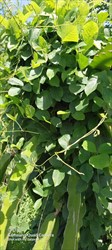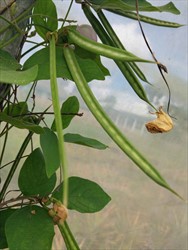Centro. It is also known as butterfly pea, soft butterfly pea.
Pacific Pests, Pathogens, Weeds & Pesticides - Online edition
Pacific Pests, Pathogens, Weeds & Pesticides
Centrosema (541)
Centrosema molle. It was previously known as Centrosema pubescens, but most authorities now consider molle and pubescens are separate species, and molle is the species in the Pacific. It is a member of the Fabaceae.
Africa, Asia, North, South and Central America, the Caribbean, Oceania. It is present in Australia, Fiji, Federated States of Micronesia, French Polynesia, Guam, New Caledonia, Northern Mariana Islands, Palau, Papua New Guinea, Samoa, Solomon Islands, and Tonga. It is native to South America.
Note, the distribution in Pacific island countries depends on whether recent collections have been made, as well as acceptance of molle and pubescens as the same or different species. Authorities now believe that it is unlikely that Centrosema pubescens is present in Oceania, and all previous identifications are incorrect, and are most likely to be Centrosema molle.
A fast-growing, aggressive perennial vine, used worldwide in the wet tropics (annual rainfall of at least 1500 mm) as a ground cover in plantations (rubber, coconut and oil palm) and as a forage for cattle. At first, slow growing, but once established develops a cover of at least 50 cm when grown alone and up to 2 m in mixtures of grasses depending on the species (Photo 1). Its ability to grow in a range of soils - from poor to fertile, sandy to heavy clay, mild acid to mild alkaline (pH 4.9-5.5 is best) - and under various levels of shade, contributes to its weediness along roadside, riverbanks, plantations and in many horticultural settings up to 600 masl. More recently centro has been recognised as an environmental weed, invading disturbed forest, destroying their structure where infestations become dense, and preventing the regeneration of native species.
Climbing stems thin, hairy, up to 3 mm diameter, branching profusely, becoming woody after about 18 months. Leaves divided into three separate dark green leaflets, up to 7 cm long and 4.5 cm wide, with pointed tips, and rounded at the base (Photo 2). Leaf stalks, up to 5.5 cm long. Flowers in small groups from the axils of the leaves, on short stalks, 3-4 mm long, pink to mauve, sometimes white, 3-4 cm across, with central keel and wide lateral (wing) petals (Photo 3). Pods are flat, up to 15 cm cm long and 7 cm wide, thicker at the margins, dark brown, containing up to 20 seeds (Photo 4). Seeds mottled brownish black. Centro has a strong taproot, with nodules of Rhizobium nitrogen-fixing bacteria on the fibrous roots.
Note, some differences between molle and pubescens are: (i) molle has larger and more pointed leaves, (ii) longer flower stalks; and (iii) different seed colour. However, it is suggested that identifications are made by expert taxonomists familiar with the distinctions between the species.
Spread short distances by seed in mud attached to vehicles, footwear, and in dumped garden waste. Stem pieces produce roots at nodes. Long distance spread is by seed shared internationally to establish the legume in plantations, pastures and between fallows of horticultural crops. The trade in seed is very active through the Internet.
Centro, most likely, Centrosema molle, is invasive in New Caledonia. It has also become a problem in dragon fruit plantations in Samoa. In tropical regions of northern Queensland and the Northern Territory of Australia, it is now regarded as an environmental weed. It is managed by community groups and listed as an 'undesirable plant' in the Wet Tropics Heritage Area of northern Queensland.
Centro (Centrosema pubescens) has been reported a weed in the West Indies in many crops, but worse in sugarcane and banana. It is also an invasive weed of sugarcane in Reunion and Australia.
Centro has a long history of use as a green manure, a source of protein as a forage, a ground cover in plantations, and as a pasture legume intercropped with grasses or grown alone. Use is common in Southeast Asia, Pacific islands, and Australia. It suppresses other weeds and fixes nitrogen efficiently.
BIOSECURITY
Centrosema is already so widely used in the tropics and subtropics, in plantations and for pastures improvement, that it might be considered that quarantines are unlikely to prevent the further spread of this potentially weedy plant. Seeds are also readily available on the Internet. If introduction is requested, a pest risk assessment would be recommended.
In this regard, the legal requirements of Queensland, Australia, may be relevant. A Government fact sheet states: "Centro is not a prohibited or restricted invasive plant under the Act 2014 of Australia, although by law everyone has a general biosecurity obligation to take responsibility and practical steps to minimise the risks associated with invasive plants under their control."
That statement relates to Centrosema pubescens; whether Centrosema molle is more aggressive and likely to be a pest of greater economic importance is not known.
BIOLOGICAL CONTROL
Not a method recommended for Centrosema molle.
CULTURAL CONTROL
Physical & Mechanical:
- Hand-pulling or digging out is possible only for isolated plants or small plantings. Established plants have a strong taproot.
- ensure all stem fragments and roots are removed; collect and burn them, otherwise they may resprout if left on or in the soil.
- Do not move topsoil from places where centro has been growing and use it elsewhere. It may contain stem and root pieces which will produce new shoots.
CHEMICAL CONTROL
In Australia (Queensland), glufosinate-ammonium is registered for use on centro in non-agricultural situations. In addition, under permit no. PER11463 (expires April 2027), several herbicides can be used against environment weeds in "non-agricultural areas, domestic and public service areas, commercial and industrial areas, bushland/native forests, roadsides, rights of way, vacant lots, wastelands, wetlands, dunal and coastal areas". BUT not in pastures. These include: picloram + triclopyr; imazapyr; imazapyr + glyphosate; metsulfuron-methyl; 2,4-D; fluroxypyr; fluazifop-P; imazapyr; triclopyr; picloram + triclopyr + aminopyralid; aminopyralid + fluroxypyr; dicamba; 2,4-D; MCPA; glyphosate; 2,4-D + picloram; and haloxyfop.
The Sugar Research Australia Limited has produced a detailed, illustrated, Weed Management Manual giving information on herbicide use (see Acknowledgements).
--------------------
Note, EU approval to use glyphosate ended in December 2022, but has been extended by one year to 15 December 2023.
_________________
When using a pesticide, always wear protective clothing and follow the instructions on the product label, such as dosage, timing of application, and pre-harvest interval. Recommendations will vary with the crop and system of cultivation. Expert advice on the most appropriate herbicides to use should always be sought from local agricultural authorities.
AUTHOR Grahame Jackson & Tommy Tuuamalii
Information from Tropical forage. Centrosema molle. (https://www.tropicalforages.info/text/entities/centrosema_molle.htmand); and Cox K (2008) pastures Australia. Centro Centrosema molle (Centrosema pubescens). A collaboration between AWI, GRDC, MLA, RIRDC and Dairy Australia. (https://keys.lucidcentral.org/keys/v3/pastures/Html/Centro.htm); and Plants for a Future. Centrosema pubescens - Benth. (https://pfaf.org/user/Plant.aspx?LatinName=Centrosema+pubescens); and Tropical F. Centrosema molle. (https://www.tropicalforages.info/text/entities/centrosema_molle.htm); and Centro Centrosema pubescens (2020) Invasive plant. The State of Queensland, Department of Agriculture and Fisheries. (https://www.daf.qld.gov.au/__data/assets/pdf_file/0005/57173/centro.pdf); and Centrosema pubescens (2021) Wikipedia. (https://en.wikipedia.org/wiki/Centrosema_pubescens); and Centrosema molle Mart. ex Benth. (2016). Weeds of Australia. (https://keyserver.lucidcentral.org/weeds/data/media/Html/centrosema_molle.htm); and Centrosema molle Mart. ex Benth. (2013). Pacific Island Ecosystems at Risk (PIER). (http://hear.its.hawaii.edu/pier/species/centrosema_molle.htm); and Heuzé V & Tran G. 2016. Centro (Centrosema molle). Feedipedia, a programme by INRAE, CIRAD, AFZ and FAO. (https://www.feedipedia.org/node/321); and Centrosema pubescens Benth. (2013) WIKTROP - Weed identification and knowledge in the Tropical and Mediterranean areas. (https://portal.wiktrop.org/species/show/56); and from Weed Management Manual. SRI Limited, 2021 edition. (https://sugarresearch.com.au/sugar_files/2021/12/Weed-Management-Manual_2021_Web_F.pdf).
Produced with support from the Australian Centre for International Agricultural Research under project HORT/2016/185: Responding to emerging pest and disease threats to horticulture in the Pacific islands, implemented by the University of Queensland and the Secretariat of the Pacific.







